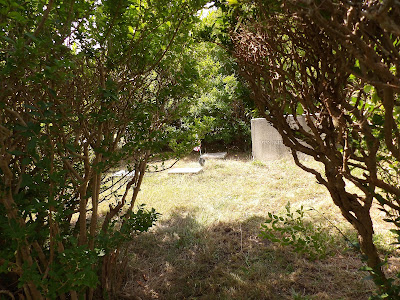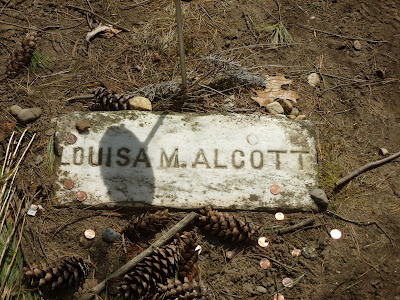 |
| Grief - Detail |
Famous Gravesite Locations
Tuesday, October 26, 2021
Adams, Henry Brooks - Washington DC
Alcott, Louisa May - Concord, MA

Louisa May Alcott
On top of Author's Ridge in Sleepy Hollow Cemetery is the family plot and grave of Louisa May Alcott. She is buried near the graves of of Henry David Thoreau, Nathaniel Hawthorn, and Ralph Waldo Emerson. She is buried in a large family plot which includes her father, Bronson Alcott, mother, and sisters. In addition to the family headstone there is a small standing headstone inscribed:
and a ground level plaque that is inscribed:
Louisa May Alcott was born in Germantown, PA on November 29, 1832 to Abigail May and Amos Bronson Alcott. She was the second of four daughters. The family moved to Boston in 1838. As a child she lived at 20 Pinckney Street in Boston, MA with her parents and her three sisters: Anna Bronson Alcott, Elizabeth Sewall Alcott, and Abigail May Alcott. Her family was part of the Boston literary scene with such friends as Ralph Waldo Emerson, Nathaniel Hawthorne, and Henry David Thoreau.
In 1860, Louisa May began writing for the Atlantic Monthly and later she wrote novels under the pen name A. M. Barnard. In 1868, while living at the Orchard House in Concord, MA, she published her most famous work, Little Women: or Meg, Jo, Beth and Amy (1868), a semi-autobiographical book about her childhood with her sisters.
Alcott died at age 55, in Boston, MA, of a stroke on March 6, 1888 and is buried on Author's Ridge in Sleepy Hollow Cemetery in Concord, MA.
Author's Ridge contains the graves of the four elite members of the Boston literary world of the 19th century. In sequential order you will find the family plots, including the graves, of these four famous contemporary authors: Henry David Thoreau ( July 12, 1817 – May 6, 1862), Nathaniel Hawthorne (July 4, 1804 – May 19, 1864), Louisa May Alcott (November 29, 1832 – March 6, 1888), and Ralph Waldo Emerson (May 25, 1803 – April 27, 1882). The Thoreau, Hawthorne and Alcott graves are clustered together while a sign points to the grave of Emerson a short distance east along the ridge.
 |
| Setting |
Writings by Louisa May Alcott:
The Little Women trilogy:
Little Women or Meg, Jo, Beth and Amy (1868)
Good Wives (1869)
Little Men: Life at Plumfield with Jo's Boys (1871)
Other Novels:
The Inheritance (1849, unpublished until 1997)
Moods (1865, revised 1882)
The Mysterious Key and What It Opened (1867)
An Old Fashioned Girl (1870)
Will's Wonder Book (1870)
Work: A Story of Experience (1873)
Beginning Again, Being a Continuation of Work (1875)
Eight Cousins or The Aunt-Hill (1875)
Rose in Bloom: A Sequel to Eight Cousins (1876)
Under the Lilacs (1878)
Jack and Jill: A Village Story (1880)
Jo's Boys and How They Turned Out: A Sequel to "Little Men" (1886)
Monday, October 25, 2021
Barnum, Phineas T. - Bridgeport, CT, USA
The family plot of Phineas T. Barnum is marked by a tall monument and individual headstones. The monument is inscribed:
P.T. Barnum was born in Bethel, CT on July 5, 1810 where he founded a weekly newspaper before moving to New York City in 1834.
In New York, Barnum creating a curiosity museum and the circus that now is part of the Ringling Bros. Barnum and Bailey Circus. His career in entertainment included a variety troupe called "Barnum's Grand Scientific and Musical Theater" and purchasing Scudder's American Museum, which he renamed the Barnum American Museum. He became famous for using the museum to promote hoaxes and human curiosities such as the Feejee mermaid and General Tom Thumb. He also promoted the American tour of singer Jenny Lind, "The Swedish Nightingale". P.T. Barnum is closely associated with the aphorism "There's a sucker born every minute."
Barnum was also served in Connecticut House of Representatives from 1866–1869 and the mayor of Bridgeport, CT from 1875–1876. He died in Bridgeport on April 7, 1891 and is buried in Mountain Grove Cemetery.
The following books authored by P.T. Barnum:
The Art of Money Getting: Golden Rules for Making Money
The Life of P. T. Barnum
Struggles and Triumphs: or, Forty Years' Recollections of P.T. Barnum
Humbugs of the World
The Colossal P. T. Barnum Reader: NOTHING ELSE LIKE IT IN THE UNIVERSE
Reader's Digest Great Biographies: Struggles And Triumphs Or The Life Of P T Barnum; The China I Knew; The Life And Death Of Adolf Hitler; An Exceptional Marriage, Louisa Catherine And John Quincy Adams
Animal Stories: An Account of the Author's Famous Expedition in Search of Wild Animals for the Circus
Selected Letters of P.T. Barnum
The Art of Money Getting and Letter to John Greenwood
The Wild Beasts, Birds and Reptiles of the World: The Story of Their Capture
 |
| Setting |
Bellamy, Edward - Chicopee, MA
MARCH 26, 1850
MAY 22, 1898
EMMA S. BELLAMY
FEBRUARY 12, 1861
SEPTEMBER 4, 1956
BELLAMY A. EARNSHAW
APRIL 21, 1912
OCTOBER 13, 1959
 |
| Inscription |
Edward Bellamy was born on March 26, 1850 in Chicopee, MA. He attended Union College of Schenectady, NY for two semester before leaving school travel in Europe for a year, spending much of this time in Germany. Upon his return home he became a journalist on the staff of the New York Post before returning to Massachusetts to take a position at the Springfield Union newspaper. He quit journalism to devote himself completely to writing both short stories and novels. Edward Bellamy's writings include:
Six to One: A Nantucket Idyl., 1878.
Dr. Heidenhoff's Process, 1880.
Miss Ludington's Sister: A Romance of Immorality, 1885.
Looking Backwards 2000–1887, 1888.
"How I Came to Write Looking Backward", May 1889.
"Principles and Purposes of Nationalism" December 19, 1889.
"The Programme of the Nationalists" 1894.
Equality, 1898.
The Blindman's World and Other Stories, 1898.
The Duke of Stockbridge: A Romance of Shay's Rebellion, 1900.
"Edward Bellamy: Selected Writings on Religion and Society", 1955.
Apparitions of Things to Come: Edward Bellamy's Tales of Mystery & Imagination, 1990.
The novel Looking Backwards is Edward Bellamy's most famous work. His concerned with social and economic justice inspired this novel. The book describes a Utopian vision for American society in the year 2000. The vision expressed in this book led to the formation of Bellamy Nationalist Clubs and a political movement that became known as Nationalism. Looking Backwards has been described as the basis for 19th century liberalism in America.
 |
| Setting |
Bellow, Saul - Brattleboro, VT
The grave of Pulitizer and Nobel Prize winning Canadian-American author Saul Bellow is located in the Shir He Harim Jewish Cemetery section of Morningside Cemetery in Brattleboro, VT. His grave is marked by a larger, upright, granite, family monument and a horizontal ground level monument. The family monument is inscribed with the family name BELLOW. A dado in the lower left corner is inscribed in Hebrew and English. The English inscription is:
Saul Bellow was born Solomon Bellows on June 10, 1915 in Lachine, PQ, Canada.When he was 9 years old his family moved to Chicago, IL, USA. He attended the University of Chicago, Northwestern University, and graduate school at the graduate work at the University of Wisconsin.
While as a merchant marine during World War II he wrote his first novel Dangling Man in 1944. He continued a writing career while he taught at several colleges and universities. During is life he published the following novels and novellas:
The Victim (1947)
The Adventures of Augie March, (1953) National Book Award for Fiction
Seize the Day (1956)
Henderson the Rain King (1959)
Herzog (1964), National Book Award
Mr. Sammler's Planet (1970), National Book Award
Humboldt's Gift (1975) , winner of the 1976 Pulitzer Prize for Fiction
The Dean's December (1982)
More Die of Heartbreak (1987)
A Theft (1989)
The Bellarosa Connection (1989)
The Actual (1997)
Ravelstein (2000)
In 1976, Saul Bellow was awarded the Nobel Prize in Literature "for the human understanding and subtle analysis of contemporary culture that are combined in his work."
Benchley, Peter - Nantucket, MA
Peter Benchley
N 41° 16.648 W 070° 06.674
1940 - 2006
 |
| Setting |
Peter Benchley was born on May 8, 1940 in New York City. He was educated at Phillips Exeter Academy and Harvard University. His first book, a travel memoir called Time and a Ticket related his worldwide travel experiences the year after he graduated from Harvard University. After serving in the Marine Corps Reserve he accepted a position as a reporter for The Washington Post. In 1967 he was speechwriter for President Lyndon B. Johnson.
In 1971 he conceived the idea of a novel about a man-eating shark that terrorized a community. This led him to write the novel Jaws about a giant great white shark. The book became a worldwide sensation and was made into a film directed by Steven Spielberg. Benchley contributed to the screenplay. The film had an even greater impact on the public. To this day many people are afraid of going into the ocean. Unfortunately, Jaws gave sharks a villianous image which Benchely later tried to correct by becoming an environmental activist.
Subsequently, Peter Benchley wrote the novels The Deep, Beast, White Shark, The Island, The Girl of the Sea of Cortez, Shark Life: True Stories About Sharks & the Sea, Shark Trouble, Rummies, Q Clearance, Shark!: True Stories and Lessons from the Deep, The Ruins and several compliation volumes.
 |
| Entrance to family plot. |
Bronson, Charles - West Warren, VT
November 3, 1921
August 30, 2003
Cherished Husband
and Father
I am not here, I do not sleep.
I am a thousand winds that blow.
I am the diamond's glints on snow.
I am the sunlight on ripened grain.
I am the autumn's gentle rain.
When you awaken in the morning's hush.
I am the swift uplifting rush.
Of quiet birds in circled flight.
I am the soft stars that shine at night.
Do not stand at my grave and cry.
I am not here, I did not die.
 |
| Setting |


















